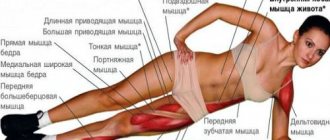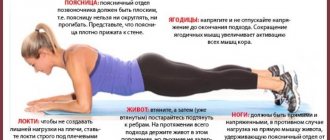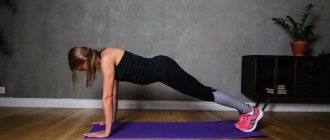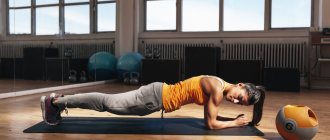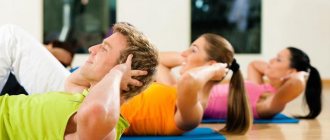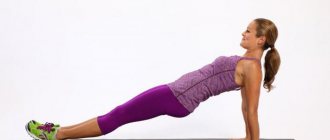Many of us lead a sedentary lifestyle, move little, suffer from excess weight, especially for residents of large cities, although many provincials are not at all averse to gaining a slim figure. There is never enough time or money to go to the gym or fitness center, and regular exercise does not give a good effect. This is where the plank exercise comes to the rescue - simple exercises, only 10-15 minutes. a day, at home.
The plank is a very useful exercise that allows you to quickly lose weight, strengthen your body, and straighten your posture. This will be discussed in the article.
Plank for weight loss - the best exercises for the whole body
The plank is an isometric exercise that provides a static, strength load on the abdominal and core muscles. During its execution, the abs, the area between the shoulder blades and the lower back, forearms, hips and buttocks are involved. It is presented in various versions depending on the complexity of execution, suitable for both beginners and professional athletes.
The plank works well as part of a routine, along with other exercises for problem areas. Before it, you definitely need to do a short warm-up, and after - stretching.
Kinds
There are different plank options. Selecting the right one depends on the level of physical fitness, desire to experiment and achieve excellent results. The classic model is for beginners, and for those who are already familiar with it, you can create a whole set of exercises from different stances.
Classic
- Lie down on your stomach.
- Bend your elbows at an angle of 90°, take a lying position. The body resembles a straight line from head to heels.
- The support falls on the forearms and toes (or rather, their tips).
- Elbows should be located under the shoulders.
- The abdominal muscles are tense and do not relax for a minute.
- Fixation time is from 20 seconds to 5 minutes.
Lateral
The side plank is more effective than the classic exercise, since only 2 support points hold the weight. As a result, you need to not lose your balance and strain your body.
- Lie on your right side.
- Place your elbow under your shoulder.
- The left hand is on the left thigh.
- Tighten your abs, raise your pelvis until a diagonal forms.
- Fix for 30-50 seconds.
- Do the same on the other side.
With your leg up
This plank reduces the area of support, which leads to an increase in the load on the abdominal muscles. So if you are looking to lose weight around your waist, this option is ideal for you.
- Get into a classic plank position.
- Raise your straightened leg up above your shoulders. The position of the body should remain unchanged.
- Pull the toes on the raised leg towards you.
- Fixation - 30-40 seconds.
- Repeat the same for the other leg.
With your hand raised
A very effective option for weight loss, but only suitable for the most trained. It is a classic, but the support is only on one hand. The second is moved either to the side or behind the back. Hands change one by one.
Lateral complicated
One of the most difficult plank forms, but incredibly useful for weight loss, since all the muscles of the hips and abdomen have to work hard.
- Lie on your side. Connect straightened legs.
- Place your left forearm so that your elbow is under your shoulder.
- Raise your body to a straight line.
- Raise your right limbs up.
- Lock in for as long as possible.
- Repeat the same for the other side.
On the ball
If you love fitball and are already accustomed to the classic plank, combine these techniques and the fat folds will go away even faster. The main thing is to stay on the ball without pulling your neck into your shoulders.
- Repeat the classic version of the plank, resting your elbows not on the floor, but on the fitball. You can first kneel down, leaning on the ball, and roll it forward until your back straightens.
- Straighten your knees.
- Hold for 2-3 seconds.
- Lower your knees slightly and touch the floor.
- Initial position.
- Repeat 7-15 times for 3 approaches.
You can perform various exercises in the plank, combining them with each other into the most effective complexes. The main thing is to learn how to accurately do a classic stance.
What is a plank?
The plank is an exercise that helps strengthen the rectus and oblique abdominal muscles. It has several different options, which differ in the complexity of implementation and the area that works in the process.
The exercise is quite popular in the fitness field. It is part of various comprehensive, functional training. Its varieties are found in yoga and Pilates classes.
Types of planks:
- classic - on straight arms;
- classic - on the elbows;
- lateral;
- with twist;
- with push-ups;
- with arm or leg extension.
There are many options for implementation. New ideas are constantly appearing to complicate the classic version. But for those losing weight, something else is important - is it possible to get rid of excess weight in this way, will such an exercise help to remove the stomach and sides.
Training Recommendations
In order for the elbow plank exercise to bring the desired result, it is important to adhere to certain rules.
Time under load
For beginner levels of training, it is recommended to start with 10-15 seconds of holding the position. From workout to workout, try to increase the duration.
For intermediate and advanced levels of training, time under load is often measured in minutes. But this does not mean that you need to break records for 5-10 minutes.
The exercise serves primarily to enable a person to control the correct position of the body in space.
This helps to protect the musculoskeletal system when more complex, dynamic exercises are performed. Especially if additional weight is used.
There is no point in holding the plank for more than 1-2 minutes. It is better to perform several approaches, while maintaining the most correct technique. Or complicate the exercise by adding dynamics.
Relaxation of the target muscles means it's time to finish the set.
Number of approaches
When holding the plank for up to 30 seconds, it is done in 3-4 approaches, with a rest interval of 30-60 seconds. This scheme is more suitable for beginners.
More experienced practitioners tend to hold the position for a longer period of time, using fewer approaches. For example, 45-90 seconds in 2-3 approaches, with a rest of 15-30 seconds.
Complication options
The most affordable option for making planks more difficult is to increase the time under load.
If we talk about the position on the elbows, then more complex exercises will be the plank on the elbows on 3 points of support - with one raised arm or leg.
If these methods turn out to be easy, use dynamics. For example, an elbow plank with body rotation, with legs moving to the side, etc.
Should you do the exercise every day?
The plank came to the world of fitness from yoga. There this exercise has been performed for more than three thousand years, every day.
It is used not only during training, but also as a separate exercise for charging.
Contrary to popular belief, the elbow plank burns little energy (about 4-5 kilocalories per minute). The body recovers very quickly after such a load.
By the way, it is precisely because of the low energy consumption that the bar is not suitable for weight loss.
Effective weight loss is, first of all, a properly balanced diet with a calorie deficit.
It is believed that success in burning fat depends 70% on nutrition and only 30% on exercise. But given the energy costs, the bar in this regard is far from being in first place.
Does it help with weight loss?
The plank is a good strength exercise that affects the abdominal muscles. It effectively works through them and helps strengthen them. But for weight loss, this is not what is important, but a calorie deficit: you need to spend more than you eat.
To burn an impressive amount of calories, you will have to hold the bar all day! Therefore, there is no point in hoping that she will burn off the kilograms that have accumulated over the years.
But the plank can, even should, become part of a set of physical exercises combined with proper nutrition, as well as complex group psychotherapy for correcting eating habits.
Plank exercise for weight loss
What muscles work
It is very difficult to achieve the correct position without understanding which muscles work in a reverse plank. Because of the static load, the ability to focus on each muscle area becomes essential.
The main burden falls on:
- Core muscles.
- Gluteal.
- Lower back.
The back plank exercise also involves:
- Shoulders.
- Triceps.
- Rectus abdominis muscle.
- Biceps femoris.
- Caviar.
At first, some muscle areas may make it difficult to do a reverse plank correctly. This is due to weakened tone, low endurance and other reasons. However, after just a few weeks, the lagging muscles become stronger and no longer limit subsequent progress.
Benefits of the plank
The plank is a good functional exercise that does not require special equipment, sportswear, or a lot of space. Almost anyone can do it. In addition, it has a number of other advantages:
- minimum amount of time to complete;
- there is no need to visit the gym, you can exercise at home;
- can be performed even after meals, no need to eat certain foods before and after training;
- has a small number of contraindications;
- improves overall well-being and coordination of movements.
The exercise is suitable for strengthening muscles, but it will not help you lose weight.
Contraindications
While performing the exercise, you need to listen to your feelings. If you feel discomfort somewhere, for example, pain in the joints or muscles, you need to stop immediately and wait until your physical condition is completely stabilized. If the pain persists, you should consult a specialist; it could be a pinching or sprain.
In addition, it is prohibited to perform the plank in the following cases:
- spinal injuries, displacement of intervertebral discs, hernia;
- high blood pressure;
- diseases of the cardiovascular system;
- postoperative period;
- during a cold or flu, in acute inflammatory diseases.
Girls during menstruation need to be especially careful when performing the exercise. Tightening your abdominal muscles can cause cramping, pain, or increased bleeding. It is also not recommended to perform the plank for pregnant women or women who have recently given birth.
Efficiency
As already mentioned, the plank is a type of exercise that helps strengthen the core muscles. Correct, regular exercise will help tighten your torso and make it more prominent. Efficiency and results are largely determined by the following factors:
- regularity: you need to do the plank at least three times a week;
- number of approaches: it is better to create a full workout that combines different types of planks;
- correct execution, strict adherence to technique;
- proper nutrition, healthy sleep, daily routine, correction of eating habits - without this, the bar will not give any results.
If you do the plank regularly for at least 30 days, you will notice the first results. Usually the condition of the skin changes: it becomes smoother, tighter, which creates a general impression of weight loss.
The benefits and harms of plank exercises
The effectiveness of the exercise is observed in strengthening the abs and other muscle groups, losing weight and improving posture. Repeating it daily at home gives noticeable results within a couple of weeks. Physical endurance increases - each time it becomes easier to do the exercise, and the duration of the stance increases. Before you begin, you should find out what the benefits and harms of planks are.
For the spine
The plank is a static exercise that is performed with a straight back, and it affects the spine. During execution, the core muscles are strengthened. This further contributes to:
- straightening the back;
- the emergence of the habit of walking upright;
- disappearance of lower back pain.
A person who regularly performs the plank becomes more resistant to strength training, and the likelihood of injuring his back decreases.
The exercise can also cause harm to the back - if there are problems with the spine and improper fixation of the body, the condition may worsen. In rare cases, injuries occur.
REFERENCE! Back pain occurs in professional athletes and people with a sedentary lifestyle at different ages. Correct execution of the plank helps eliminate discomfort.
For legs and feet
Depending on the type of plank chosen, the degree of impact on the leg muscles varies. The classic pose gives the least tension; the action of the more complicated variants is aimed at working the leg muscles.
The benefits are as follows:
- legs become slimmer;
- a beautiful muscle relief appears;
- buttocks are tightened;
- cellulite disappears;
- physical endurance increases when running.
Damage to the legs occurs if there are problems with the ankle or knees, or if complicated plank variations are performed incorrectly. If the load is distributed unevenly and the main emphasis is on the damaged area, then the exercise can worsen the condition. By studying how the plank exercise is performed, you will be able to eliminate the possibility of problems.
REFERENCE! Strengthening the leg muscles increases the effectiveness of all types of training, making a person more resilient and active.
For weight loss
The role of exercise for weight loss is to speed up your metabolism. Strengthening muscle mass leads to faster burning of fat deposits. The skin tightens along with the muscles, which is especially important during weight loss.
The plank is useful for the press - it helps to achieve a beautiful relief.
With the combination of proper nutrition and daily exercise, the weight loss process accelerates.
How long to stand in plank
The optimal time is selected individually. For an unprepared person, 10 seconds will be enough, while an athlete can withstand up to 10 minutes. What happens to the body as time increases:
- In the first 20-30 seconds, a feeling of tension appears, which increases with every second. At the same time, blood circulation in working areas increases, oxygen is actively supplied. The body spends about 5 calories on all this. For beginners this will be enough.
- After a minute, a feeling of warmth and slight trembling appears. It seems that the muscles have “clogged” and become dense and stone-like. Usually at this stage people give up because they don’t want to endure discomfort or pain at all.
- After three minutes, a “second wind” opens. Pain and discomfort subside a little, the body gets used to the load. At this stage, it is better to stop and start again - this way the training will be more effective.
- It is not recommended to hold the plank for more than 10 minutes - this is fraught with destruction of muscle fibers.
Most fitness instructors believe that it is better to do several repetitions of 30 seconds each than to stand for 3-4 minutes at a time. So the body will not have time to get used to the load and adapt. Each new approach for him is a new test, which will become more and more difficult to cope with.
Regularity of classes
Classes must be regular. It is best to spend a few minutes after completing morning exercises on the plank, when the body is already warmed up and ready for the load.
If you can’t immediately do the number of approaches required by the program, you can divide the lesson into two parts: one done along with exercises, the other 2-3 hours after dinner, shortly before bedtime. If there is also a workout in the evening, it is better that it also includes a plank.
If progress is not observed with regular exercise, you should pay attention to the following points:
- load intensity: if the body is accustomed to a regular exercise, you can not only increase the time, but try a more difficult version, and thus control the process;
- incorrect execution technique. In the next paragraph of the article, we will consider the correct sequence and typical mistakes of beginners.
The main thing is to understand that it is not so much the quantity that matters, but the quality of training.
How to do it right
The execution technique looks like this:
- feet are shoulder-width apart;
- the elbows are strictly under the shoulder joints;
- the gaze is directed downwards to the fingers, the neck is straight;
- the stomach is pulled in, there is no deflection in the lower back;
- legs, abdominal muscles and arms are tense.
The name of the exercise describes the technique: the torso should be extended in a straight line - a plank. There should be no deflections anywhere.
The technique seems simple at first glance. However, mistakes do happen, especially for beginners. The most common are the following:
- The pelvis is higher than the head. In this position, the load is redistributed and transferred to the muscles of the arms and forearm. In this case, discomfort is felt in the shoulder joints.
- Bend in the neck, lift the head. When performing the plank, you need to look down at your fingers. When you move your gaze forward, a deflection is formed in the neck, increasing the load on the cervical vertebrae. This is especially dangerous for people suffering from osteochondrosis.
- Elbows set too wide. Maintaining balance in this state is not easy. The load on the back muscles, shoulder joints and elbows increases. All this can lead to injury.
- Bend in the lower back. When performing the exercise, you must monitor your body position. It should be straight, like a bar, like a string. Otherwise, pain in the lower back may occur.
If you perform the plank incorrectly, you can avoid harming yourself. Therefore, you should not chase increasing the time; it is better to hold it for ten seconds, but correctly.
Reverse plank - execution technique
This variation is similar to the classic position, but done in reverse: your body resembles a coffee table. The reverse plank is especially recommended for people with back pain. In this technique, the time that you stand is not so important as the correctness of all actions.
Reverse plank
How to do it: sit on the floor and straighten your legs. Place your palms on the floor and spread your fingers to distribute the load evenly. We tilt the torso back to the floor at an angle of 45 degrees. We place our hands behind the buttocks in line with the shoulders. Raise your torso, legs and butt until they are extended in a straight line. We tense our abdominal muscles. We start with 20 seconds and increase the time. Slowly return to the starting position.
Reverse plank with leg raised
Tip: If you feel your hips starting to sink, stop and do another set after a minute.
The most common mistakes when performing a reverse plank are the head thrown back/chin pressed to the chest/non-compliance with the geometry of the exercise. When the load goes into the hands, the remaining muscles stop working at full strength.
With limb extension
For beginners
Beginners only need 4-5 minutes of training per day. This time is enough to get used to the load and prepare for other, more difficult exercises.
Beginners can use the following program:
| An approach | lead time |
| First | 10-30 seconds |
| Second | 30-45 seconds |
| Third | 30-45 seconds |
| Fourth | 10-30 seconds |
If after one circle you still have strength, you can repeat it about 2-3 times. This workout can be done in the morning and evening.
The main thing is to develop a habit and do exercises regularly.
Training program
The main mistakes when doing the plank: relaxed abdominal muscles, buttocks and legs, sagging lower back and uneven weight distribution, bent knees, head raised up.
Typically, beginners cannot hold this position for more than 20-30 seconds. This is normal for an untrained person. But to achieve visible results, this time needs to be increased to 5 minutes, no less.
Perform the exercise 2-3 times every day, allowing yourself rest no more than once a week. In this case, every day the time for performing the plank should be increased by 10 seconds. If you can’t do it by 10, increase it by at least 5. Thus, in just a month you can get closer to the cherished 5 minutes and record the first results in losing weight.
There are superset schemes consisting of various variations of this exercise. They allow you to work out the maximum number of muscles in 10-15 minutes.
However, you should not set yourself the goal of quickly increasing the time it takes to complete the exercise. It is better to concentrate on technique and correct body position. It is advisable to conduct the first training in front of a mirror in order to independently control the correct position of the torso, arms and legs.
Many experts recommend focusing not on time, but on sensations. The appearance of a strong burning sensation in the abdomen is a signal that you should stop doing the plank. It’s better to do another approach after some time than to chase a certain number of minutes and seconds.
The first week of training will be the hardest. Muscles that are unaccustomed to such loads will ache. You can relieve pain with massage and hot baths. However, by the end of the week the body will get used to the stress and the discomfort will disappear.
For men
The program for men is somewhat more difficult than for beginners and women. It involves the use of several types of planks in one complex with maximum development of the core muscles. Representatives of the stronger sex are usually able to hold the desired position longer due to the natural characteristics of the body, strong arms and back.
The program for men may include the following types of planks:
- classical;
- lateral;
- with alternate raising of arms and legs;
- with weights.
For each approach there is a separate version of the plank. The duration of one approach is from 45 to 60 seconds. Men can perform about 3-5 laps in one workout.
Plank for men and women: is there a difference?
The plank for the abdomen and other muscles is a universal exercise that is suitable for both men and women. Moreover, during execution, women demonstrate greater endurance than representatives of the stronger half. It is worth noting that it increases endurance and burns fat, but is not suitable for building muscle mass. That is why, if a man wants to make his body more prominent, then in addition to static exercises, he will have to perform a number of strength loads. You can also read reviews from those who have been practicing for a long time.
For women
It is biologically determined that excess weight in women mainly accumulates in the abdomen and hips. Because of this, representatives of the fair sex develop a huge number of complexes and lack confidence in themselves and their beauty. Wanting to correct the situation, they go on strict diets and torture their bodies with intense training.
But, in fact, you can lose weight without serious dietary restrictions. Once you change your habits, the excess weight will go away on its own. But old, harmful activities must be replaced by new, healthy ones. Another option is regular training, including a plank.
A program for women might look like this:
- approach one – classic plank on straight arms or elbows;
- second approach – lateral (on the left hand);
- third approach – lateral (on the right hand);
- approach four - again classic on straight arms or elbows.
For the best effect, you need to make about three such circles. The duration of each approach is 30-40 seconds.
21 plank options
Traditional plank
This is the most basic form of exercise and works your entire body. The only thing to remember is that your hands should be directly under your shoulders and your body should be in a straight line.
Target muscles are core, glutes, shoulders and biceps.
Technique:
- Your arms should form a straight line from your shoulders to your elbows.
- Raise your body and keep the weight on your palms and toes.
- Keep your back straight.
- Don't strain your neck. Keep your abs engaged by drawing in your stomach.
- Hold the position for at least 30 seconds.
- Release and repeat.
Rest - 20 seconds
Repetitions - 2 more times
Elbow stand
The forearm or elbow plank, also known in yoga as the Delphic pose, works exactly the same as the first exercise, but it also targets the muscles of the upper back and shoulders.
Target muscles are core, glutes, shoulders, latissimus dorsi and biceps.
Technique:
- Get into a plank position. Keep your abs tight and your body in a straight line.
- Make sure your hands are under your shoulders.
- Make a right fist, bend your right elbow, and leave your entire forearm on the floor. Do the same with your left hand. You will now be in a lower position, making the task more difficult.
- Make sure your elbows are under your shoulders and flat on the floor. Hold this pose for 15-30 seconds.
Rest - 20 seconds
Repetitions - 2 more times
Side plank on elbows
The side plank is a variation of the elbow plank. Although this option puts a little more pressure on your shoulders, it is easier to maintain balance with this type of plank.
Target muscles are core, glutes, adductor magnus, external and internal obliques and biceps.
Performance:
- Lie on your right side and support your upper body with your elbow and forearm on the floor, perpendicular to your shoulder. Bend both knees slightly and bring your legs together. Place your right hand on the right side of your body.
- Slowly lift your buttocks higher and hold this pose for 30 seconds.
- Repeat on the other side.
Rest - 20 seconds
Repetitions - 2 more times
4. Side plank arm and leg raise
This is an extended variation of the elbow side plank. It will challenge your flexibility, endurance and balance.
Target muscles are core, glutes, adductor magnus, external and internal obliques and biceps.
How to do:
- Lie on your right side and support your upper body with your elbow and forearm on the floor, perpendicular to your shoulder. Bend both knees slightly and bring your legs together.
- Raise your hips and then lift your left leg up.
- Raise your leg as high as you can and try to keep it level with your raised arm.
- Repeat on the other side as well.
Rest - 25 seconds
Repetitions - 2 more times
Plank with hip drop
This variation is very effective for toning your thighs and slimming your waist. It targets your obliques, abs, and even your lats.
Target muscles are core, glutes, adductor magnus, external and internal obliques, shoulders and biceps.
Technique:
- Get into a side plank position.
- Lower your hip to the floor and lift it again.
- Do 10 repetitions on each side.
Rest - 20 seconds
Repetitions - 2 more times
Plank with side hip touches
Hip twists are one of the best plank exercises for toning your waist and strengthening your core.
Target muscles are core, glutes, adductor magnus and biceps.
Technique:
- Get into a plank position on your elbows.
- Roll your hips and touch the floor with each thigh in turn.
Rest - 20 seconds
Repetitions - 2 more times
7. Side plank on one arm
This is a variation of the traditional plank. It is very effective for correcting posture and toning the back muscles.
Target muscles are core, glutes, adductor magnus, obliques and biceps.
Technique:
- Place your right palm on the mat with your fingers pointing straight ahead. Bend your left knee and place your left leg in front of your right leg.
- Lift your hips toward the ceiling, lift your left arm off the floor, and support your body on your fully extended right arm and the outside of your right leg. Raise your left leg and place it on top of your right leg.
- Hold the position for 15-20 seconds and then repeat on the other side.
Rest - 20 seconds
Repetitions - 2 more times
"Star"
This is a variation of the one-arm side plank. It is aimed at advanced level athletes and requires great balance skills.
Target muscles are core, glutes, adductor magnus, obliques and biceps.
Technique:
- Place your right palm on the mat with your fingers pointing straight ahead. Bend your left knee and place your left leg in front of your right leg.
- Begin to lift your hips toward the ceiling, lift your left arm off the floor and lift it and support your body on your fully extended right arm and the outside of your right leg. Raise your left leg and place it on top of your right leg.
- Raise your left leg so that your body is in a completely open position, as if you are about to hug someone very tightly!
- Hold this pose for 15 seconds, release and repeat on the other side.
Rest - 20 seconds
Repetitions - 2 more times
Plank with roll
The rollover plank is both a strengthening and cardio exercise that is great for your hips, waist, core, and arms. This plank can be done both on the hands and on the elbows.
Target muscles are core, glutes, obliques, shoulders, biceps, wrist flexors and extensors.
How to do it:
- Start in a forearm plank position and make sure you have form on the right.
- Raise your right arm and rotate your body to the left into a side elbow position.
- The difference here is that you don't stack your legs on top of each other. Simply twist and come back to the forearm position and then rotate to the other side.
- Without losing your balance, continue to turn from side to side. The movement will be something like this - from the center to the right and back again.
- Make 20 rolls to complete one set.
Rest - 20 seconds
Repetitions - 2 more times
Plank with Leg Raise
This type of plank strengthens the entire upper body. By lifting one leg, you activate your core stabilizers.
Target muscles are core, glutes, obliques, shoulders, biceps, wrist flexors and extensors.
How to do:
- Assume a regular plank position.
- Raise one leg as high as you can or until it is parallel to the ground. Hold for 10 breaths.
- Lower that leg and lift the other one.
Rest - 20 seconds
Repetitions - 2 more times
Double plank
This is a challenging exercise (but fun) that helps build strength and endurance.
Target muscles are core, glutes, obliques, shoulders, biceps, wrist flexors and extensors.
How to do:
- Assume a regular plank position.
- Get into a plank position on your elbows.
- Straighten your left arm and then your right. Return to standard plank position.
- Do 10 reps to complete one set.
Rest - 25 seconds
Repetitions - 2 more times
12. Side Twist Plank
The side crunch plank is an intense workout for your abs.
Target muscles are core, glutes, obliques, shoulders, lower back and biceps.
Technique:
- Get into a regular plank position and tighten your abs.
- Bend your left knee, turn it to the side and touch your elbow.
- Straighten your leg back and repeat with the other leg.
- Repeat 15 times on each side to complete one set.
Rest - 25 seconds
Repetitions - 2 more times
Plank on fitball
This bar requires a fitball. This way you will strengthen the work of your main stabilizers.
Target muscles are core, glutes and biceps.
How to do it:
- Place your arms, elbows bent, on the exercise ball, shoulder-width apart.
- Stretch your legs back and gain balance.
- Hold this pose for 15 seconds or until you feel a burning sensation in your muscles.
Rest - 15 seconds
Repetitions - 2 more times
Plank with twists
This plank is great both as a cardio exercise and as an exercise for the abdominal muscles.
Target muscles are core, glutes, hamstrings, quads, shoulders and biceps.
How to do it:
- Assume a standard plank position.
- Raise your left leg, bend your left knee, bring it towards your chest and return your leg to the starting position.
- Repeat with your right leg.
- Repeat 20 times to complete one set.
Rest - 15 seconds
Repetitions - 2 more times
Plank with dumbbell row
This plank variation requires a set of dumbbells.
Target muscles are core, glutes, shoulders and biceps.
Technique:
- Grab a pair of dumbbells and get into a plank position.
- Bend your elbow and bring the dumbbell to your chest.
- Repeat on the other side. Do 10 reps for each arm.
Rest - 15 seconds
Repetitions - 2 more times
16. Plank with feet on a fitball
In this variation, your feet rest on an exercise ball. This reduces pressure on the core muscles.
Target muscles are core, glutes, shoulders and biceps.
How to do it:
- Place the ball behind your back.
- Get into a plank position. Place your feet on the ball.
- Hold this pose for 10-25 seconds.
Rest - 15 seconds
Repetitions - 2 more times
"Peak"
Again, this is a great cardio variation of planks for the lower abdomen and back.
Target muscles are core, glutes, shoulders, lats, hamstrings, hamstrings, quads, triceps and biceps.
Technique:
- Get into a regular plank position.
- Stand on your toes and push your hips up. Form an upside down "V" shape. Don't strain your neck.
- Hold this pose for 3 seconds and then return to plank position.
- Repeat 10 times to complete one set.
Rest - 15 seconds
Repetitions - 2 more times
Reverse plank
The reverse plank is a fairly difficult exercise, but if you follow our steps and do everything gradually, you will succeed.
Target muscles are core, glutes, shoulders, lats, hamstrings, quads, triceps and biceps.
Technician:
- Sit on the floor, straighten your legs in front of you, and put your hands behind your back and place them shoulder-width apart.
- Using your arms to support your weight, lift your butt off the floor until your body forms a straight line from your shoulders to your feet. This is the reverse bar.
- Hold this pose for 10-20 seconds.
Rest - 10 seconds
Repeat - 3 more times
Reverse plank with leg raise
The reverse plank leg raise increases the tension your core muscles are subjected to in order to stabilize.
Target muscles are core, glutes, shoulders, lats, hamstrings, quads, triceps and biceps.
Technician:
- Sit on the floor in a reverse plank position, but keep your knees bent so that your thighbone and shins are at right angles to each other.
- Slowly lift one leg up, straighten it and hold it. Make sure you lift your leg straight.
- Hold this pose for 10-15 seconds.
Rest - 10 seconds
Repetitions - 2 more times
20. Plank with leg kick
This is another challenging but effective variation of this exercise.
Target muscles are core, glutes, shoulders, lats, hamstrings, quads, triceps and biceps.
Technique:
- Assume a regular plank position. If you are a beginner, then stay on your knees. But if you are at an intermediate or advanced level, stand in a standard plank.
- Raise one leg and bend it. This is your starting position.
- With a sharp impulsive movement, straighten your leg and lift it even higher.
- Do 12-15 pulses.
- Do the same with the other leg.
Rest - 10 seconds
Repetitions - 2 more times
Low bar
This is an isometric movement where you will move throughout the exercise.
Target muscles are core, glutes, shoulders, lats, triceps and biceps.
Technique:
- Get into a plank position.
- Bend your elbows and lower yourself into the bottom push-up position.
- Hold it for 10 seconds and then return to a regular plank.
Rest - 15 seconds
Repetitions - 2 more times
These are 21 variations of the plank that will help get your body in order and train endurance. Believe me, dear women, that the result in the photo and in the mirror will not keep you waiting. If you want to challenge yourself, you can gradually increase the time you do this cool exercise.
Body correction with a plank
The main benefit of regularly doing the plank is strengthening the muscle corset. The body changes visually, becomes stronger and more toned.
In addition, when performed correctly, it can bring the following benefits:
- strengthening the back muscles, which is especially important for people who lead a predominantly sedentary lifestyle (office employees, schoolchildren, students, retirees);
- reduction of pain in the neck and spine - the plank exercise is often included in the complex of physical therapy prescribed by a doctor;
- increasing endurance, since standing in the plank for a long time is not easy, muscles tense, trembling appears, and you need to overcome yourself in order to defend the required time;
- improved blood circulation, active supply of oxygen to cells;
- improved mood - when performing any physical exercise, the production of hormones is activated, including dopamine and serotonin.
Weight loss plank: reviews
- Marina, 21 years old: “I have a sedentary job, I don’t move much, I began to gain excess weight, and I became loose. I read about the plank exercise and became interested. I’ve been working out regularly for almost a month now, I feel more energetic, and my weight is gradually decreasing.”
- Tanya, 18 years old: “I don’t have problems with being overweight, but I decided to try the plank as a preventative measure, and I was right! My posture has improved, my muscles have become stronger, and I have a flying gait! And the guys started paying more attention to me!”
- Igor, 32 years old: “I always thought that this bar was a purely feminine problem. But at the request of my wife, I decided to try it to lose some weight. It takes a little time, but there is a result. Even after two weeks of training, I began to feel much better, my abs became stronger, and things are going to the point that soon the treasured “packs” will appear in place of the abdomen.
- Inna, 28 years old: “I just started doing the exercise, I’ve only been doing it for a week. There is no visible result yet, but internally I have become much more cheerful, more collected, stronger. There was a desire to continue, and confidence in the result!”
We introduced you to a very simple, accessible and at the same time very effective plank exercise. Its regular implementation helps to improve well-being, strengthen muscles, lose weight, be slim, and at the same time does not require material costs and does not take much time.
Sports articles on the site:
- Rules for performing abdominal exercises
- How to lose weight with hypothyroidism
- Sports nutrition for joints and ligaments
- How to force yourself to exercise
- How many hours after eating can you exercise?
Plank options
Let's take a closer look at several basic plank options.
Classical
The ideal option for beginners is the classic one. It is recommended to master it first; it allows you to remember the technique, as well as understand which muscles are involved in the work and how the body reacts to it.
Beginners can do simplified options:
- spread your legs a little wider, but make sure that the load does not transfer to your shoulders and forearms;
- perform on straight arms, not on elbows;
- make approaches shorter in time, but increase their number.
Advanced athletes can try more difficult options:
- perform while standing on your elbows;
- keep your feet together with your heels touching;
- increase the duration of one approach;
- use leg weights;
- do push-ups during breaks.
It is important to select a complex according to your own feelings. Then it will not be perceived as torture, it will be made more comfortable every time.
Side plank
The side plank is performed while standing on one arm. In this case, the lateral abdominal muscles and waist are mainly involved in the work. You need to hold each side for at least 15 seconds.
During execution, you need to ensure that the body is extended in one straight line. There should be no sagging in the pelvic area or severe discomfort in the shoulder joints. It is better for beginners to perform it on straight arms, for advanced ones - on their elbows.
You can complicate the option by using weights for the legs and dumbbells for the arms. It will be very difficult to stay statically in this position.
Planks with limb extension
After the classic version has been mastered, you can move on to complications. To do this, use a bar with an arm extension. People call her “Superman”. The position of the usual exercise is assumed, after which one arm is raised straight in front of you or slightly to the side. The pose is fixed for at least 30 seconds.
You can make the exercise even more difficult by simultaneously tearing off your left arm and right leg. Then vice versa. The exercise works well on the muscles of the back, arms, and abs.
The main thing, as in other options, is to follow the technique, and do not forget that the whole body should be elongated in one line.
How long should you keep it?
Many people think that they will be cool and successful and have abs of steel if they plank for more than 5 minutes at a time. But not everyone stands in the right place.
At best, for the first 30 seconds this test of the spine's strength is similar to a plank, but then it looks more like medieval torture, and in this case it is also voluntary. Standing in the plank for 5 minutes or some other specific number is not the main thing.
The most important thing is to defend your own maximum with the correct technique. For one person, 30 seconds will be enough, but for another, more prepared person, even five minutes will not be enough.
Here you need to build on your capabilities . If all your muscles are already burning, but you still control the technique, then be patient and keep going. If only 40 seconds have passed, and you are shaking like a chihuahua with a fan blowing on it, then you don’t need to stand for another 2 minutes simply because that’s what they wrote on the Internet.
Yes, you can, of course, stand in the plank for 9 hours and break the world record for the elbow plank of one Chinese man. But you have to keep in mind that he didn’t set this record spontaneously, because he completed the production plan for children’s toys for the year in just a week and he just got bored. He went to this record for years.
Therefore, you should not rush for some abstract numbers . How long you need to hold the plank position on your elbows depends only on your capabilities and sensations.
Program “30 days around the bar”
You can find many different programs on the Internet. The most popular of them is “30 days around the bar.” Its main condition is to challenge yourself and practice every day, increasing the time, no matter what. This plan lasts 30 days and looks like this:
| Day | Time in seconds | Day | Time in seconds |
| 1 | 10 | 16 | 120 |
| 2 | 10 | 17 | 120 |
| 3 | 20 | 18 | 120 |
| 4 | 20 | 19 | 150 |
| 5 | 30 | 20 | 150 |
| 6 | 30 | 21 | 150 |
| 7 | 40 | 22 | 180 |
| 8 | 40 | 23 | 180 |
| 9 | 50 | 24 | 210 |
| 10 | 50 | 25 | 210 |
| 11 | 50 | 26 | 240 |
| 12 | 60 | 27 | 240 |
| 13 | 60 | 28 | 270 |
| 14 | 90 | 29 | 270 |
| 15 | 90 | 30 | 300 |
This program will help the body adapt and get used to a new type of load.
Weight loss plank for beginners, table
A monthly program for beginners might look like this:
| Day | Time in seconds | Day | Time in seconds |
| 1 | 20 | 16 | rest |
| 2 | 25 | 17 | 60 |
| 3 | 25 | 18 | 65 |
| 4 | 30 | 19 | 70 |
| 5 | 30 | 20 | 65 |
| 6 | 35 | 21 | 70 |
| 7 | 35 | 22 | 80 |
| 8 | rest | 23 | 80 |
| 9 | 35 | 24 | rest |
| 10 | 40 | 25 | 90 |
| 11 | 40 | 26 | 90 |
| 12 | 45 | 27 | 95 |
| 13 | 50 | 28 | 95 |
| 14 | 50 | 29 | 100 |
| 15 | 60 | 30 | 100 |
The proposed program can be modified to suit you, adding 5-10 seconds daily.
